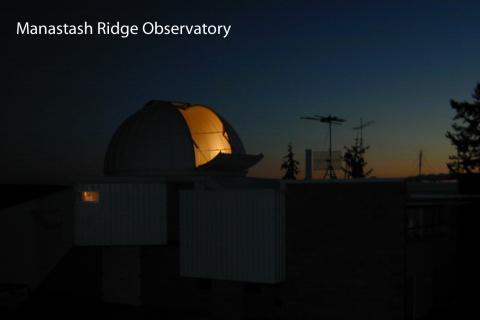Forty years after its dedication, it's time to make changes at the University’s Manastash Ridge Observatory (MRO) that reflect the realities of how we use the facility, and respect our impact on natural resources, particularly our water and energy consumption.
The UW Astronomy department built MRO in 1972 at a location outside of Ellensburg, Washington, chosen for its good weather, proximity to Seattle, and because electrical and telephone utilities could be brought in. However, it was far too remote for city water service, so the architects incorporated a water storage tank, which is regularly filled by deliveries from a water pumping truck. The system has worked well, but current reality is that the water tank supply is not as sanitary as city water, and the deliveries are expensive at roughly one thousand dollars per visit. As a result, we ask each observing team to carry their own drinking and washing water up with them, but water and electricity remain MRO’s second and third largest budget items.
We seek to both conserve the resources we use and sustain the observatory for the future by reducing our reliance on outside resources. Our plan for conservation is to construct a kitchen that is not plumbed to running water, to replace the previous kitchen’s energy inefficient fridge and range as well as our original “maximum flush” toilets, and to install LED lighting for our working and living areas. In order to reduce our overall environmental impact, and to demonstrate the possibilities for sustainable construction, we also propose to construct a rainwater catchment system and solar grid-tie system with battery reserve. The latter option could potentially make us the first observatory capable of solar-powered astronomical observations.
The four components of this proposal (conserving water, conserving energy, capturing rainwater, and solar power) are relatively independent upgrades, but together they complement each other and maximize the effect each has individually. The budget for each part does not necessarily correspond to the magnitude of the improvement we expect from each aspect, and we do not expect each to pay-off financially on a short time scale. However, each component will play a unique role in making our astronomical observatory (MRO) a demonstration site and amplifying our educational goals. We submit this proposal as four parts that stand alone and can be funded independently, but submit together to increase their impact.
Campus Sustainability Fund Requirements and Preferences:
Environmental Impact
Conservation of water and energy are the primary goals of our proposal. In particular, we estimate that the installation of low-flow toilets will cut the number of water deliveries in half. Fewer water deliveries mean fewer diesel emissions from the water truck we hire to bring river water up to our remote observatory. The use of LED bulbs, which are much more efficient than our current incandescent lighting, will also reduce heat in the living spaces of the observatory during the Central Washington summer when the observatory is open. We predict that the rainwater catchment system, for a modest cost, will further eliminate another thousand dollar water delivery each year, and the solar system we are designing should be sufficient to effectively take the observatory off the grid during our summer observing season.
Student Leadership & Involvement
The UW’s astronomy club, the League of Astronomers, has contributed their expertise to this proposal as representatives of the people who spend their nights working there each summer. These students, many of whom spend over a week’s worth of time at MRO each summer, know the needs and patterns of observing at MRO better than anyone else.
In addition many projects at MRO are already carried out by volunteer work parties drawn from our awesome undergraduate users. The observatory would not be the vibrant and special place it is today without the energy and ideas of the undergraduates who stay there each summer. We’re lucky that MRO has been adopted as a special place for the undergraduate astronomers, and we know we couldn’t propose and implement this work without their support.
Education, Outreach, & Behavior Change
Observing at MRO has always meant taking care of the facility and its land. We will build upon the expectation of care for the observatory, and make daily measurements a part of our procedures. It seems that awareness of consumption is often used to promote conservation (like cars that display their instantaneous mpg, or buildings that display their energy use). MRO users will be expected to post daily reports noting, among many other telescope or facility issues, the level of the water tank and the status of the solar array’s battery bank. We anticipate that bringing light to each group’s water and power consumption will lead to some good-natured competition to conserve.
Additionally, these systems will make MRO a leading demonstration site in sustainable practices. While some systems in this proposal are highly visible (solar arrays), others will be unfamiliar (the foot pump kitchen sink, which comes from marine systems), but each will create a facility that incorporates our commitment to conservation and sustainability.
Feasibility, Accountability, & Sustainability
Facility work such as this is well within the expertise of our network of volunteers, some of whom are facilities maintenance professionals, or represent tasks that can be contracted out to professional tradespeople. The equipment we propose to use is readily available for our purposes. They are well tested and long lasting, combined in a way to achieve our goals.
Budget Estimates
Water and Energy Conserving Kitchen, parts and labor: $3,000
White and red LED lighting Systems, parts: $1,000
Rainwater Catchment, parts: $ 1,000
Solar Powered Telescope Operations, parts and labor: $30,000
Project Management: $5,000
Total: $40,000 parts & labor
